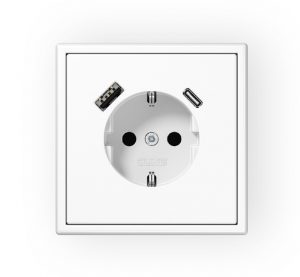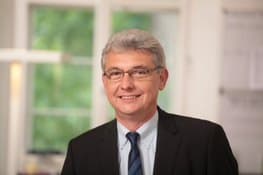
Jung
Forever Jung
What do the federal chancellery in Berlin, the Van Gogh museum in Amsterdam or the Shangri-La hotel in Shanghai have in common? They all rely on solutions from Germany´s Sauerland region for their building technology.
In the municipality of Schalksmühle, the
has been developing and producing award-winning innovations for controlling lighting, blinds, air conditioning, security and communication technology for more than 100 years. With its new development center, the medium-sized company emphasizes that agility at Jung is not just a hype, but much more an attitude.
When Stefan Jörgens talks about the new SCHUKO® socket outlets with integrated USB sockets, the head of development at the premium supplier Jung from Sauerland goes into raptures. He, of course, raves about the product presented for the first time this year, but almost more so about the way it was created. “Many did not think that we could fully internally integrate mechanics, electronics and software,” says the graduate engineer, who has headed the R&D department since 2011. The secret to success: For the first time, Jung focused on agility in mechatronic product development. “The team was given complete freedom,” reveals Jörgens. “Nevertheless, we did not simply implement an agile manifesto one-to-one but always considered agility as the logical further development of our previous R+D toolbox based on a lean development approach.”

Managing Director Martin Herms sees this pilot project as a good example of the typical “Jung approach” in terms of agility : “We learned to question ourselves and our methods in a very targeted manner and always include everyone involved – employees, managers and shareholders – from the very beginning.” This was also the case ten years ago. Together with Dr. Andreas Romberg from Staufen AG, Jung completely restructured its innovation management. “Jung never lacked creativity, but 200 simultaneous development projects simply blocked the pipeline back then,” Romberg recalls. “In the beginning, I admit that sometimes things could not move fast enough, but in the end the typical Jung approach ensured that lean development methods were anchored in the company in a very sustainable manner.”
“Changing the culture of innovation is a long-term process”
In the meantime, however, others also benefit from this development. As a BestPractice partner of Staufen AG, Jung regularly shares its experience with companies whose innovation and development processes are still at the very beginning of their journey from lean to digitalization to agility. But those who expect a magic formula from Herms, Jörgens and co. have not understood what is really at stake. “Get ready to reflect on your very own culture of innovation,” advises Jung Managing Director Herms to all lean development novices. “It is about establishing an attitude in your own company, not copying a solution as closely as possible. Changing the culture of innovation is a long-term process.”
Jung has long since reached the next stage after completing the restructuring of its development division last year. “If you question your processes and tools, at some stage you will reach a point where you may have to also change the working environment,” says R+D Manager Jörgens, summarizing the motivation for the spatial redesign. And here too, employees were involved in this process right from the start. Many features of the new working worlds, e.g., magnetic walls you can write on in team and project rooms, are based on their suggestions and wishes. Together with organizational developers and spatial planners, a balance between openness and transparency and calm and concentration was then translated into an impressive spatial language.
Spatial redesign
“Agility means discipline”
Despite the “great positive response” (R+D Manager Jörgens) to the new space, Managing Director Herms continues to remind us that agility above all means discipline. In addition, the cultural foundations must first be established and an absolute customer orientation created so that concepts such as lean or, in the future, agility can demonstrate their strengths. Herms’ clear message: “Culturalwork before content-related work!”
Let us return to the USB SCHUKO® sockets which thanks to Quick Charge can charge an iPhone 11, for example, to 100% in about 100 minutes without blocking the socket with a charger. Would this kind of new product have been conceivable without Jung’s previous “journey”? Development Manager Stefan Jörgens notes, “the manner in which we develop gives us the freedom to think about what we are developing.” And Martin Herms adds, “we have always very consciously focused on the entire innovation process. Meaning, how do we come up with the right ideas and how do we bring the right people together to turn these ideas into innovations and ultimately marketable products.”
Please feel free to contact me if you want to get any further information
DR. ANDREAS ROMBERG, Senior Partner, STAUFEN.AG
Management of several major projects of Lean Transformation in development areas of different industries
Master Coach and Executive Trainer for Lean Leadership
phone: +49 7024 8056 0, e-mail: contact@staufen.ag




